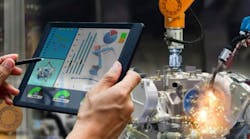Parker-Hannifin, Ingersoll Rand Execs Sustain Optimistic Notes on Demand
Amid a rather dour earnings season and during a week featuring middling-to-poor data points from the Institute for Supply Management and the Bureau of Labor Statistics, investors and market watchers looking for optimism could find nuggets in the conference calls from industrial bellwethers Parker-Hannifin Corp. and Ingersoll Rand Inc.
After reporting quarterly results and forecasts that helped their shares climb nearly 10% Thursday and Friday, executives of both companies said they still see global demand for their products broadly holding up, even accounting for some customers’ focus on trimming their inventories as well as several Asian economies’ inability to gain traction.
“We still continue to have a relatively healthy backlog and that is reflected in terms of what we expect to ship in Q4,” Ingersoll Rand CFO Vik Kini told analysts on a conference call. In addition, he added, the company is seeing “relatively healthy and good, strong momentum” for compressors, vacuum and blower equipment, power tools and lifting equipment.
“We would expect to see that continue into Q4,” Kini said.
Ingersoll Chairman and CEO Vicente Reynal said another encouraging indicator is that the North Carolina-based conglomerate’s flow of marketing qualified leads shows “continued momentum,” suggesting that few buyers are severely tightening their reins. On top of that, Reynal said, planning work on megaprojects such as semiconductor and electric-vehicle battery plants is beginning to turn into actual orders.
That last idea was echoed at Cleveland-based Parker-Hannifin, where executives raised their fiscal-year guidance and stuck by their 1.5% organic sales growth target, by President Lee Banks.
“When I think about the North American markets […], you can’t find any weakness,” Banks said Nov. 2. “What’s going on in aerospace, commercial, military, OEM, [maintenance, repair and overhaul]—all really strong. And I don’t see that stopping for some time.”
Yes, Banks added, some customers are focusing on working down inventories, “but things are not falling off a cliff.” Parker’s overall order backlog finished the September quarter at 54% of sales expected over the next 12 months, down only a tick from mid-year.
The upbeat commentary and outlook from Parker and Ingersoll executives fit better with the nonresidential construction picture painted by the Associated Builders and Contractors than with the recent on-the-other-hand assessments from leaders of Illinois Tool Works Inc. and Stanley Black & Decker Inc. or the Texas manufacturing executives surveyed by the Federal Reserve Bank of Dallas. Their more optimistic assessment is reflected in the Census Bureau’s index of manufacturers’ new orders, which turned positive year-over-year in August for the first time since April and moved up solidly in September.
There are idiosyncratic elements, too, to the Parker and Ingersoll stories: The former has in recent years relied on a series of acquisitions (of filtration company Clarcor and aerospace parts maker Meggitt, among others) to make it less susceptible to shorter-cycle spending while Ingersoll has honed its process of buying small specialist firms and plugging them into its global sales network.
“We’re not immune to the market but it’s all about controlling what we can control,” Reynal told analysts. “And this is what our teams have done exceptionally well.”




